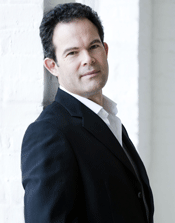What was striking in this performance of Les Pêcheurs de Perles (Pearl Fishers) at the Royal Opera House was how delicate much of Bizet’s writing really is. It doesn’t jump up and grab you like the tunes from Carmen. Bizet knew little about India or Indian music but in his imagination, the exoticism signaled refinement. A petit Trianon East, perhaps, charming, but as authentic as 18th century “oriental” wallpaper. Since we nowadays know more of the reality, which affects our response to Bizet’s watercolours.
Dispense with the “orientalism” and think of Les Pêcheurs de Perles as French fantasy, and the opera falls into perspective. Kings and Priests dominate because peasants are superstitious, and think Holy Virgins will protect them. When the chorus sings of Brahma they could as easily be singing of Jesus. Getting away from literal images allows the music to make sense on its own terms.
 Gerald Finley
Gerald Finley
Antonio Pappano was wise to let this music breathe. Over-expansive gestures are best left to the histrionic narrative. Bizet imagines India in delicate, refined string textures, flute trills and gently beaten cymbals. Crescendi build up like swells in the ocean, diminuendos evoking refinement and submission. Lovely bell-like miniatures throughout evoking an idea of the East as perfumed and flower strewn as a church in France on a holy day. There’s more drama in this music than the opera is given credit for. Pappano elucidates what’s there, without pushing it past its limits. The delicacy of the playing let themes, such as those from the “big number”, resurface elusively throughout the opera, sometimes so subtle they can be overpowered by being made too obvious..
The Royal Opera House orchestra deserve more appreciation than they get, so it was good to see them on stage rather than hidden in the pit. Seeing the bare structure of the stage was instructive, too, a reminder of just how much art goes into making the fantasy of opera.
 John Osborne
John Osborne
Leila is a part almost tailor-made for Nicola Cabell. She’s exquisite, and swathed in sapphire satin creates a character even before she sings. Pretty singing too., but the role, despite its charm doesn’t lend itself to great displays of passion. John Osborne’s Nadir was assertive and lucidly clear in the true French manner. His aria “Je crois entendre encore”, was beautifully shaped and balanced, the orchestra poised around it nicely, so it did feel “caché sous les palmiers.”
The duet “Au fond du temple saint” was very well realized by Osborne and Gerald Finley. Finley was by far the biggest name in the ensemble, however good Osborne, Cabell and Raymond Aceto’s Nourabad could be. More darkness would work better with Zurga, who is a very troubled man indeed, but Finley’s singing is so well modulated that he creates authenticity without much apparent effort.
Anne Ozorio


